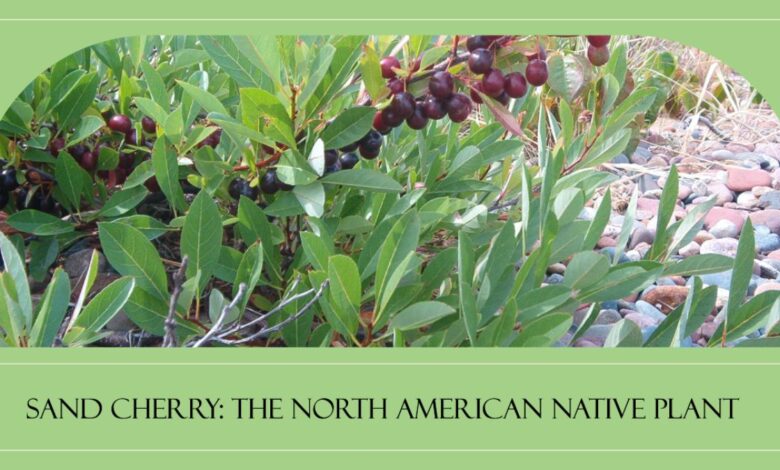Versatile Sand Cherry: Edible Fruit and Landscaping

The sand cherry (Prunus pumila var. besseyi) is a versatile, cold-hardy shrub that deserves greater use for its beauty and practical benefits. This underappreciated North American native plant produces edible summer fruit, serves wildlife, stabilizes soil, and delivers multi-season visual interest to landscapes and gardens across a wide climatic range.
Table of Contents
Introduction to Sand Cherry: A Fruitful, Hardy Shrub
Sand cherry, also known by names like western sand cherry, Bessey’s cherry, and rocky mountain cherry, belongs to the rose family (Rosaceae) and cherry/plum genus Prunus. It is a deciduous, cold-hardy shrub growing 1-2 meters tall and wide, with a suckering, spreading habit that can form dense thickets.
Its oval, toothed leaves emerge with a reddish tint in spring, deepen to a lush green into summer, then turn vibrant shades of orange and red in fall before shedding. Clusters of small white flowers cover the branches in spring, producing tiny plump purple-black cherries in early summer. Both the tart and mildly sweet fruits and flowers lend themselves well for jams, juices, pies and more.
Beyond its edible yields, sand cherry makes a hardy ornamental plant, thriving in full sun with well-drained, even poor soils across USDA zones 3-6. It requires little care while stabilizing ground and feeding wildlife. But what truly sets this plant apart is its versatility – providing beauty and practicality across so many fronts.
Topics Covered in This Article
This comprehensive guide will explore sand cherry’s key strengths:
- Origins and growing range
- Physical appearance and growing conditions
- Edible and food uses
- Value as an ornamental plant
- Wildlife and habitat benefits
- Soil erosion control and land restoration capacities
- Cultivars and availability
Discover why this North American native deserves wider appreciation and use for its multi-faceted offerings.
Also Read: The Unique Smyrnium perfoliatum: A Relative of Alexanders
Sand Cherry Classifications and Native Range
Sand cherry (Prunus pumila var. besseyi) is one variety of the dwarf cherry Prunus pumila species, with some naming it as a subspecies instead. Some sources also place it in the Cerasus genus of tart cherries instead of Prunus.
Regardless of exact taxonomy, this is a distinct plant with key characteristics. Its native range covers central North America, spanning sand hills and prairies from Saskatchewan down across Montana, the Dakotas, Nebraska, Colorado and beyond.
Given its preference for sandy or rocky soils, it’s particularly suited to the conditions found in parts of Colorado, especially in the foothills and mountainous regions where such soils are prevalent. It can be found growing in natural habitats as well as cultivated landscapes and gardens throughout the state.
It thrives in these arid, exposed sites with lean, quick-draining soils. Unlike most other cherries, sand cherry tolerates drought, high pH, salinity, and poor nutrition while fixing itself strongly in place. Such adaptability and fortitude helps explain this plant’s expansive climatic resilience.
Growth Habit and Physical Traits
Sand cherry forms a round, spreading shrub reaching around 1.5-2 meters (5-6’) tall and wide at maturity. Its maximum dimensions depend partly on variety, with some more compact selections for smaller spaces.
Numerous long flexible stems radiate out from the base, arching gracefully under the weight of leaves, flowers and fruit. Stems often layer themselves by touching ground and rooting where nodes contact soil. The extensive root system stretches widely but not deeply, extensively colonizing its terrain.
Leaves: Emerging red-tinged in spring, oval finely-toothed leaves mature to medium green in summer, measuring around 2-5 cm long. By autumn, they transition through vibrant oranges and reds.
Flowers: Small five-petaled white flowers appear from late April into early May, often completely cloaking the bare branches in bloom. Showy though lacking scent, they draw pollinators before making way for fruit.
Fruit: Tiny round cherries 8-18 mm wide ripen from late June through July, persisting briefly into early August. Their dark purple skin and red juicy flesh surround a single large pit. Both sweet and tart flavors mingle in the fresh fruit.
Bark: On younger stems, the bark appears reddish-brown and shiny with small horizontal lenticels. Older bark dulls to gray-brown with scaly plates.
Cold Hardiness and Climate Range – Thanks to its extreme durability, sand cherry reliably withstands winter temperatures from -40° F to -50° F (-40° C to -46° C) once fully dormant. It thrives in USDA zones 3 to 6, spanning most of the northern U.S. and even into Canada. Heat tolerance also ranks high, though fruit quality declines in especially hot, humid southern climates.
Ideal Growing Conditions
Sand cherry requires full sun exposure coupled with well-drained soil. Though adaptable to varied conditions, it particularly favors sandy, gravelly, even poor rocky ground where many other plants would struggle. The following details provide growing guidance:
Soils – Most soils except wet clay suit sand cherry. Sandy, gravelly soils enrich growth and fruiting. Tolerates pH range of 6.1 to 8.5.
Sun – Full sun is mandatory, with at least 6 hours direct light daily. Light shade reduces growth and fruits.
Watering – Drought tolerance is high once established. Prefers moderate moisture, accepting short dry spells. Root rot can occur in heavy wet soils.
Propagation – Easily grown from seed or semi-ripe summer cuttings. Nursery plants offer faster establishment.
Maintenance – Requires little pruning unless containment or shaping is desired. Occasional thinning of oldest branches keeps plants vigorous. Fertilizer generally not necessary in enriched garden soils.
Also Read: How Organic Home Remedies Can Transform Your Health
Harvesting and Eating Sand Cherry’s Edible Fruits
The crowning glory of sand cherry comes in early summer when abundant petite purple-black cherries adorn every branch. Tart with hints of sweetness when fully ripe in July, sand cherry makes a fun nibbling fruit fresh off the bush. More commonly though, cooks harness these small cherries in sweet and savory preparations.
The fruits cling firmly to their stems when ripe, so gently twist to harvest without crushing. Expect yields around one quart per mature shrub (2+ years old). Enjoy fresh for a week or two in cool storage, or preserve through freezing, dehydrating, canning, or processing into juices, jams, compotes, honey, syrups, vinegar and wine.
Sand cherry shines brightest in sweet applications like jams, jelly, fruit leather, pie fillings, cider, sorbet and more. Blending with other berries expands flavor dimensions. Their bright acidity also suits savory glazes for meats and sauces. Dried cherries carry convenience for year-round enjoyment.
Medicinal Uses Disclaimer
Divya Ayush Care cannot be held responsible for any adverse effects resulting from the use of plants for medicinal purposes. It’s always advisable to seek advice from a healthcare professional before using any plant medicinally.
Ornamental Value for Gardens and Landscapes
Beyond its tasty fruits, sand cherry wins favor as a stellar ornamental shrub suited to gardens and landscapes across its hardy climatic range. It delivers multi-season beauty coupled with urban tolerance, drought resilience, and wildlife support:
- Spring flowers present a magnificent display, cladding bare branches prior to leaf emergence. The floral show precedes ornamental cherries, extending early season garden beauty.
- Summer foliage takes over in a lush medium green curtain that persists cleanly if given ample sun and air flow. The dense bush offers habitat and shelter for small animals.
- Come autumn, sand cherry’s foliage transforms to brilliant warm shades of red, orange and purple, holding for several weeks before dropping. Its fall color rivals season showstoppers like burning bush (Euonymus alatus) but with fruit and greater resilience.
- Even in winter, the intricate web of arching maroon branches maintains sculptural interest — accented by persistent ripe fruit for hungry birds.
Hardy through freezing winters, sand cherry always leafs out vigorously again each spring. This reliable resilience, coupled with its compact rounded form occupying modest space, makes it a natural fit for smaller urban and suburban gardens.
Also Read: Longevity Spinach: A Medicinal Herb with Health Benefits and Culinary Uses
Sand Cherry’s Role in Supporting Wildlife
Gardeners prize sand cherry for its varied benefits, but this hardy shrub also plays a profound role in sustaining diverse wildlife across its native range. At a time of dwindling global biodiversity, that makes sand cherry an even more valuable landscape plant.
Birds relish sand cherry’s summer fruits, stopping to feast on ripening berries in mid-summer through early fall migration. Up to 50 species across multiple families visit the shrubs, playing key parts in seed dispersal. The list includes American robins, cedar waxwings, pine grosbeaks, bluebirds, sparrows, finches, jays, orioles, and even wild turkeys.
Mammals like red foxes, rabbits, raccoons, black bears, squirrels and others also consume fruits directly from bushes or off the ground below. Fallen seeds readily germinate to propagate new generations.
Pollinators flock to the early spring flower nectar, including vital bees and other critical insects. Sheltering foliage and dense cover later offer nesting sites and protection.
Soil health receives a boost as sand cherry’s extensive roots fix nitrogen while extensive ground cover protects the soil biome. The plant partners closely with essential beneficial fungi like mycorrhizae.
Such interconnected support across guilds of living organisms helps demonstrate sand cherry’s exemplary credentials as a steward of ecological balance.
Combating Erosion and Restoring Native Habitats
With its hardy adaptive resilience across habitats from loose slopes to battered shorelines, sand cherry has proven itself a supreme erosion control and restoration plant. It not only passively armors disturbed ground against water and wind forces, but actively rebuilds soil structure and fertility to allow other native plants to colonize.
Sand cherry secures itself strongly even in loose sandy soils thanks to an anchoring taproot coupled with far-reaching shallower roots. Extensive suckering forms dense colonies resilient against gully washouts and mudslides. Yet it grows tamely with more civilized companions, making it ideal for reinforcing landscapes.
Its problem-solving prowess has been harnessed for revegetating road cuts, stabilizing sites stripped of topsoil, guarding stream banks, and reclaiming mining spoils. Several Department of Transportation districts specify sand cherry for its dual-use erosion control and visual appeal. It also helps repair drastically disturbed areas like pipelines, construction zones, and newly installed infrastructure.
Beyond sheer soil anchoring, sand cherry enriches the terrain it occupies. Nitrogen-fixing root nodules fertilize nutrient-poor sands and clays. Fungal networks amplify benefits. Dropped leaves and pruned branches compost to organic matter. Over time, colonized ground becomes hospitable for other native ferns, wildflowers, grasses, and young trees.
Also Read: Power of Essential Oils: Its Uses and Health Benefits
Sourcing Sand Cherry Plants, Cultivars and Seed
As appreciation grows for this North American native shrub, sand cherry has become increasingly available from plant nurseries and seed suppliers across much of its climatic range. The shrub’s cold hardiness makes it well-suited to northern and high elevation western states where few other fruiting plants thrive.
Those seeking sand cherry plants or seeds have several sourcing options:
- Local nurseries – Check for sand cherry at local garden centers, or request special ordering from regional nurseries. Retail availability is highest in states overlapping its native range like Nebraska and the Dakotas, but custom plant orders can expand options.
- Online mail order – Various nurseries ship sand cherry shrubs nationwide, expanding options beyond regional choices. Reputable sellers should detail cold hardiness zones, growth rates, size estimates and other specifications to match plant stock to local growing conditions.
- Seeds – Sand cherry grows readily from properly pretreated seed, making this an economical alternative. Scatter in garden beds and pots in fall or very early spring. Cold stratifying for a few months typically improves germination rates.
While open-pollinated seedlings deliver great genetic diversity, named sand cherry varieties graft benefits like enhanced fruit size, fall color, compact form, or vigor:
- ‘Hansen’s Bush Cherry’ – Very large flavorful fruit, spreading form to around 2 m tall/wide.
- ‘Black Beauty’ – Sweet productive black cherries ripe later (August), on a taller shrub to 3 m. Lovely ruby fall color.
- ‘Tundra’ – A natural semi-dwarf shrub with masses of white spring blooms, excellent fruit yields, and brilliant red fall foliage presenting superior ornamental appeal. Max height and width: 1-1.5 m.
Why This Underused Plant Merits far Greater Appreciation
The sand cherry presents a supreme yet underappreciated North American native shrub that delivers beauty and functionality all year round. It adapts from loose erosion-prone banks to urban garden beds thanks to its hardy resilience in the face of heat, cold, drought and poor soils across a vast climatic range.
Valued for centuries by indigenous peoples, sand cherry has yet to capture the full appreciation it deserves among modern home gardeners and landscapers. But those who discover it prize its versatility, vigor and vibrancy.
Beyond producing tasty fruit, sand cherry adds ornamental flair across seasons, feeds and shelters wildlife, controls erosion, and restores terrain stripped of life. Packaged within a compact rounded shrub requiring minimal care, sand cherry proves itself perhaps the most useful understory woody plant across continental zones 3 to 6.
The next time you seek hardy dependable beauty for yard, garden or acreage, choose sand cherry. Your land and its wild inhabitants will thank you for years to come.
FAQS:
Q1. What are the uses of sand cherries?
A1. Sand cherries have multiple uses: their berries are edible and can be used for culinary purposes, while their beautiful flowers and foliage make them ideal for ornamental landscaping. They also provide essential food and habitat for wildlife, aid in erosion control and soil stabilization, and contribute to environmental restoration efforts by re-vegetating disturbed areas.
Q2. Are sand cherries good to eat?
A2. Yes, sand cherries have a pleasant sweet-tart cherry flavor when fully ripe in mid-summer. The fruits can be enjoyed fresh or cooked into jams, juices, pies, and more. They make a tasty, versatile edible berry.
Q3. What is a sand cherry tree?
A3. Sand cherry (Prunus pumila) is actually a cold-hardy shrub in the rose family, not a tree. It grows around 1.5-2 meters tall and wide in USDA zones 3-6, thriving in full sun and sandy/rocky soils with little maintenance required.
Q4. What flavour is sand cherry fruit?
A4. Sand cherries have a mildly sweet and pleasantly tart cherry-like flavor when mature. The balance of sweetness and acidity makes their small berries very versatile for use in both sweet and savory preparations.
Q5. When not to eat cherries?
A5. Avoid eating cherries if they’re underripe, damaged/bruised, or past their prime. Underripe cherries lack flavor, while damaged ones risk decay and off flavors. Overripe cherries may have mold or a fermented smell, signaling they should be discarded.
Q6. Which cherry is best for eating?
A6. The sweet cherry varieties like Bing, Rainier and Brooks are considered the best tasting cherries for fresh eating. Their large size, crisp texture, sweetness and complex flavor deliver superior enjoyment compared to tart pie cherry types.
Disclaimer:
This article is written for basic and general informational purposes only. The Statements contained here have not been evaluated by the FDA and neither the efficacy of these products has been confirmed by FDA-approved research. All information presented here is not meant as a substitute for or alternative to information from health care practitioners.
There’s no guarantee of specific results and the results can vary. Users must not view the content as medical advice in any way. Users are also required to ’NOT SELF-MEDICATE’ and always consult their health care professional before taking any medicines or undergoing any treatment. DivyaAyushCare and the author will not be responsible for any act or omission by the User arising from the User’s interpretation of the content.

